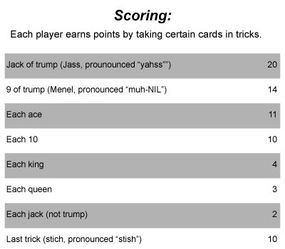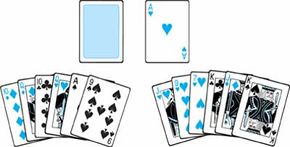Try pronouncing this card game "Klobber-yosh" -- or just call it Klob. Originally a Hungarian card game, Klaberjass became a favorite for gamblers in the United States as a one-on-one test of talent. Here's how to play:
Number of players: Two
Advertisement
Object: To score points by declaring sequences and by winning high-scoring cards in tricks (see "Sequences" section below).
The cards: A 32-card deck, A-K-Q-J-10-9-8-7 for each suit. The rank of trump cards is different from that in the other suits. Card rank in trumps: J (high), 9, A, 10, K, Q, 8, 7. Card rank in the other suits: A, 10, K, Q, J, 9, 8, 7.
To play: Deal six cards to each player, three at a time, and turn over an upcard to propose trump. Now the trump bidding begins.
Nondealer speaks first, saying "Pass," "Take," or "Schmeiss" (pronounced "shmyss").
Take means nondealer accepts the suit turned up as trump. Nondealer then becomes the "maker", or the player responsible for making the higher score. Being the maker has some serious consequences explained in the "Scoring" section.
Schmeiss is an offer to throw the hand in. If dealer accepts, the cards are thrown in and new hands are dealt. If dealer refuses, he becomes the maker with the upcard suit accepted as trump.
If nondealer passes, dealer then must pass, accept, or schmeiss.
If you both pass on the first round, nondealer names a new trump suit of the three suits remaining or passes again. If the latter, dealer now names a new trump suit or passes. If both pass twice, the hand is thrown in, with no redeal; the deal alternates in Klaberjass.
Once a suit has been settled on for trumps, each player is then dealt another three cards, bringing the total of cards in their hands to nine cards.
If the original upcard was accepted as trump, either player with the 7 of trump, called the Dix, may now exchange it for the upcard.


Sequences: Before playing out the tricks, determine which player, if either, has the highest sequence. Only the player with the highest-ranking sequence may score for sequences. For sequences only, each suit follows the order A-K-Q-J-10-9-8-7. Three or more cards in a row, all of the same suit, form a sequence.
A three-card sequence is worth 20 points; a four-card or longer sequence is worth 50 points. Naturally, a 50-point sequence is higher than a 20-point sequence. Between sequences of equal value, the one with the higher top card is higher. If the sequences tie in rank, a sequence in trump beats one not in trump. If neither sequence is trump, nondealer's sequence beats dealer's.
Nonmaker begins the dialogue, claiming "20" or "50" or "no sequence." Maker now answers, either declaring "no sequence," or announcing a higher sequence or, if the sequences have equal value, asking, "How high?"
The player whose sequence is high may also declare any other sequence in their hand, regardless of its value or rank. To score your sequences, you must show them after the first trick. The other player with the low sequence scores no sequences.
Once the sequences dialogue is over, play begins. No matter who the maker is, nondealer always makes the first lead. Thereafter, the winner of a trick leads to the next one.
A trick is won by the higher trump in it or, if it has no trump, by the higher card. You must follow suit if able. If unable to follow suit, you must trump if possible; otherwise, you may discard. If a trump is led, you must play a higher trump if able.

Bella: If you hold the K-Q of trump, declare 20 points for Bella when you play the second of of the two cards in a trick.
Scoring: Players combine their trick score with any sequences or Bella. If maker's total is greater than defender's, then both record their points. If maker and defender tie, defender's score only is recorded. If defender scores more than maker, called "bete," credit defender with both scores. First player to 500 points wins.
Tips: You won't always have a rock-crusher of a hand in the first six cards. The last three cards received can be high trumps and nice cards for sequences, or useless losers, or a mix of the good and the bad. If you become the maker needing to fill in an open sequence, you probably won't get it. With two sequences open, your chances improve a good deal.
J-Q-K or J-9-A of trump is an obvious take, but you may want to take with J-Q of trump plus some high tricks. Jack alone with two outside tricks is a very reasonable take. Also, to accept with A-K-Q of trump (40 points with Bella) and an outside ace will usually win -- unless opponent has very high trumps.
The schmeiss is a unique feature of Klaberjass. As nondealer, schmeiss when you have only a fair chance to win with the trump proposed and fear opponent may make a big score picking a different suit for trumps. Otherwise, pass and name a good suit later.
When nondealer passes, dealer should accept or schmeiss if possible rather than allowing opponent to name a new trump suit.
If opponent is nearing 500 and you are rather behind, don't become maker unless you have a chance to win big. Otherwise opponent will score enough points simply as defender.
©Publications International, Ltd.
Advertisement
